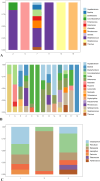Clinical performance of nanopore targeted sequencing for diagnosing endophthalmitis
- PMID: 40604405
- PMCID: PMC12220603
- DOI: 10.1186/s12866-025-04132-y
Clinical performance of nanopore targeted sequencing for diagnosing endophthalmitis
Abstract
Purpose: Rapid identification of pathogenic bacteria in the vitreous and/or aqueous humor of patients with acute clinical diagnosis of endophthalmitis via nanopore sequencing technology.
Methods: We recruited a total of 12 patients (12 eyes) who were diagnosed with endophthalmitis at an ophthalmic outpatient clinic of Peking University Third Hospital from January 2022 to October 2022. Clinical evaluation is conducted in the order of consultation, symptom evaluation, physical sign evaluation, and ophthalmic special examination, all of which are completed by the same experienced clinical physician. Finally, 19 aqueous humor and/or vitreous samples were obtained via anterior chamber wash, vitreous tap and vitrectomy. The samples were separated for cultivation, biochemical drug sensitivity identification, and targeted nanopore sequencing (NTS), and the results of nanopore sequencing were validated via Sanger sequencing.
Results: In patients with endophthalmitis, NTS can identify infected pathogens within 8-12 h. Six samples (31.6%) were subjected to culture-based diagnosis, while NTS revealed the presence of pathogenic microorganisms in 19 samples (100%), of which bacteria and fungi were detected in three samples. A total of 19 samples were subjected to Sanger sequencing, of which 16 (84.2%) tested positive, including 6 culture-positive samples and 10 culture-negative samples, of which 5 (26.3%) were positive for two bacterial genera. In culture-positive cases, there is a high-quality match between culture and targeted nanopore sequencing.
Conclusions: NTS can quickly detect pathogenic bacteria in samples from patients with endophthalmitis. Moreover, the use of vitreous and/or aqueous humor for the NTS has potential. NTS is a promising diagnostic platform for endophthalmitis, especially for mixed infections and culture-negative cases.
Keywords: 16S rRNA; Endophthalmitis; Infectious pathogens; Microbiome; Nanopore sequencing.
© 2025. The Author(s).
Conflict of interest statement
Declarations. Ethics approval and consent to participate: Our study adhered to the tenets of the Declaration of Helsinki and was approved by the Ethics Committee of the Peking University Third Hospital. (S2021222). Written informed consent was obtained from all study participants. Consent for publication: Not applicable. Competing interests: The authors declare no competing interests.
Figures



Similar articles
-
Clinico-microbiological profile of post-cataract surgery endophthalmitis and role of polymerase chain reaction in the management: A report from Eastern India.Indian J Ophthalmol. 2025 Jun 1;73(6):870-874. doi: 10.4103/IJO.IJO_2680_24. Epub 2025 Apr 17. Indian J Ophthalmol. 2025. PMID: 40243061 Free PMC article.
-
Adjunctive steroid therapy versus antibiotics alone for acute endophthalmitis after intraocular procedure.Cochrane Database Syst Rev. 2017 Feb 22;2(2):CD012131. doi: 10.1002/14651858.CD012131.pub2. Cochrane Database Syst Rev. 2017. Update in: Cochrane Database Syst Rev. 2022 Jun 6;6:CD012131. doi: 10.1002/14651858.CD012131.pub3. PMID: 28225198 Free PMC article. Updated.
-
Adjunctive steroid therapy versus antibiotics alone for acute endophthalmitis after intraocular procedure.Cochrane Database Syst Rev. 2022 Jun 6;6(6):CD012131. doi: 10.1002/14651858.CD012131.pub3. Cochrane Database Syst Rev. 2022. PMID: 35665485 Free PMC article.
-
Early vitrectomy for exogenous endophthalmitis following surgery.Cochrane Database Syst Rev. 2022 Nov 18;11(11):CD013760. doi: 10.1002/14651858.CD013760.pub2. Cochrane Database Syst Rev. 2022. PMID: 36398614 Free PMC article.
-
Ocriplasmin for symptomatic vitreomacular adhesion.Cochrane Database Syst Rev. 2017 Oct 17;10(10):CD011874. doi: 10.1002/14651858.CD011874.pub2. Cochrane Database Syst Rev. 2017. PMID: 29040800 Free PMC article.
References
MeSH terms
Grants and funding
LinkOut - more resources
Full Text Sources
Miscellaneous

